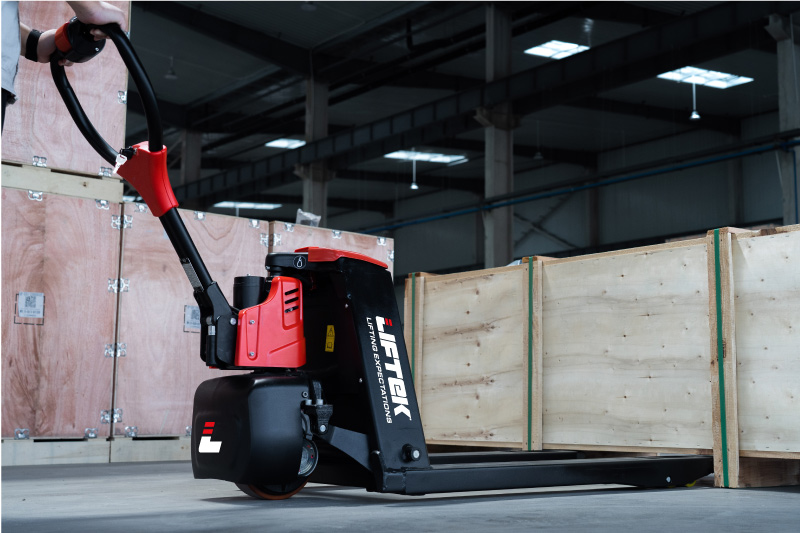Pallet trucks are great machines that bring so much to your workplace. They can give your team, your logistics and your business the edge by helping you to make light work of material handling in your workplace.
Whether you are getting your first pallet truck, or you want to add another to your current fleet, we’ve put together this comprehensive guide to what you need to know about pallet trucks and how they can help your business.
Are there any training courses available for operating a pallet truck?
In the UK, there are training courses available for operating a pallet truck. These courses provide essential knowledge and practical skills to ensure safe and efficient operation. The training typically covers topics such as equipment familiarization, pre-use checks, load handling, maneuvering techniques, and safety precautions. It is recommended to attend a certified training program to gain proper training and certification.
How do I properly load and unload a pallet using a pallet truck?
Loading and unloading a pallet using a pallet truck involves several steps:
- Position the pallet truck alongside the pallet and ensure the forks are fully inserted under the pallet.
- Lift the pallet slightly to release the weight off the floor and ensure the forks are securely engaged with the pallet.
- Carefully move the pallet truck, ensuring a clear path, and positioning the pallet at the desired location.
- Lower the pallet gradually, ensuring it is stable and safely supported before removing the forks.
Can pallet trucks be used in narrow spaces or tight corners?
Yes, pallet trucks are designed to be maneuverable in narrow spaces and tight corners. However, the specific maneuverability depends on the type of pallet truck. Manual pallet trucks are typically more compact and easier to navigate in tight areas. Electric pallet trucks, especially those with a smaller turning radius, can also operate effectively in narrow spaces.
What are the benefits of using an electric pallet truck over a manual one?
Electric pallet trucks offer several advantages over manual ones:
- Increased efficiency: Electric pallet trucks are powered, eliminating the need for manual pumping, which speeds up operations.
- Reduced physical strain: Electric pallet trucks require less physical effort to operate, reducing the risk of operator fatigue and injuries.
- Enhanced control: Electric pallet trucks often have features like variable speed control and programmable settings, allowing for smoother and more precise handling.
- Suitable for longer distances: Electric pallet trucks are ideal for applications that involve longer distances or frequent use.
How long does the battery of an electric pallet truck last?
The battery life of an electric pallet truck can vary depending on factors such as the battery capacity, load weight, operating conditions, and usage patterns. On average, a fully charged battery can last between 6 to 8 hours of continuous operation. However, it’s important to follow the manufacturer’s guidelines for charging and maintenance to optimize battery life.
Are there any special considerations when using a pallet truck in a cold storage environment?
When using a pallet truck in a cold storage environment, it’s important to consider the following:
- Cold-resistant materials: Ensure the pallet truck is constructed with materials that can withstand low temperatures without becoming brittle or damaged.
- Lubrication: Apply appropriate lubricants that can perform effectively in cold conditions to prevent freezing or seizing of moving parts.
- Battery performance: Extreme cold can affect battery performance, reducing its capacity. Consider using batteries specifically designed for cold storage applications or implementing battery warmers to maintain optimal performance.
Can pallet trucks be used to transport hazardous materials?
Pallet trucks can be used to transport certain hazardous materials, depending on the specific regulations and safety measures in place. However, it’s crucial to ensure compliance with relevant health and safety guidelines, including proper labeling, packaging, and handling procedures for hazardous materials. It is advisable to consult with regulatory authorities or safety experts to determine the specific requirements for transporting hazardous materials.
What are some common troubleshooting tips for pallet trucks?
- Check power source: For electric pallet trucks, ensure the battery is fully charged or properly connected. Verify that the power source is functioning correctly.
- Inspect hydraulic system: Check for any hydraulic fluid leaks, damaged hoses, or air in the system. Ensure all connections are secure and tighten if necessary.
- Examine wheels and casters: Inspect the wheels and casters for any obstructions, debris, or damage. Clean or replace them as needed.
- Verify load capacity: Make sure the load on the pallet truck is within its specified weight capacity. Overloading can strain the truck and cause malfunctions.
- Lubrication: Check if any moving parts require lubrication. Apply lubricant as recommended by the manufacturer.
- Reset or restart: If the pallet truck is not responding or functioning properly, try resetting it by turning it off and on again or restarting the control system.
It’s important to note that these troubleshooting tips are general suggestions. Always consult the manufacturer’s manual or contact a qualified technician for specific troubleshooting steps or repairs.
Can pallet trucks be used to transport hazardous materials?
Pallet trucks can be used to transport certain hazardous materials, depending on the specific regulations and safety measures in place. However, it’s crucial to ensure compliance with relevant health and safety guidelines, including proper labeling, packaging, and handling procedures for hazardous materials.
Whatever you need to move, there is a pallet truck to help with that. We are the experts when it comes to these versatile machines, so get in touch with our friendly team today and we can help you find the right solution for your business.

